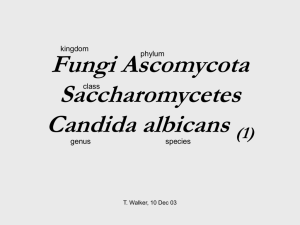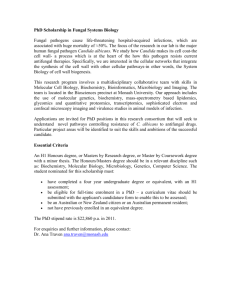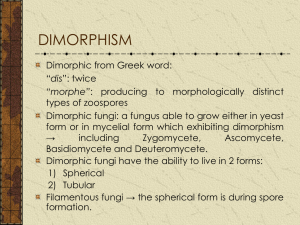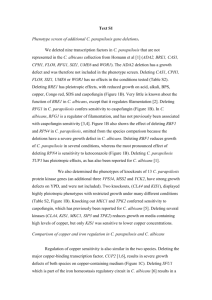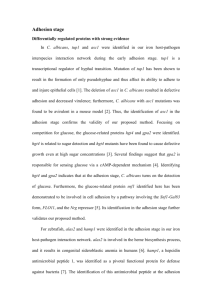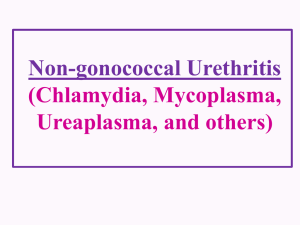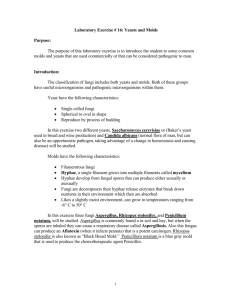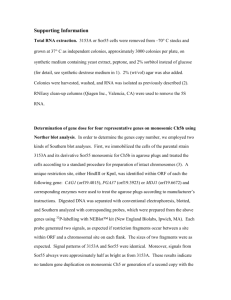Candida albicans adapts to host copper during superoxide dismutase
advertisement
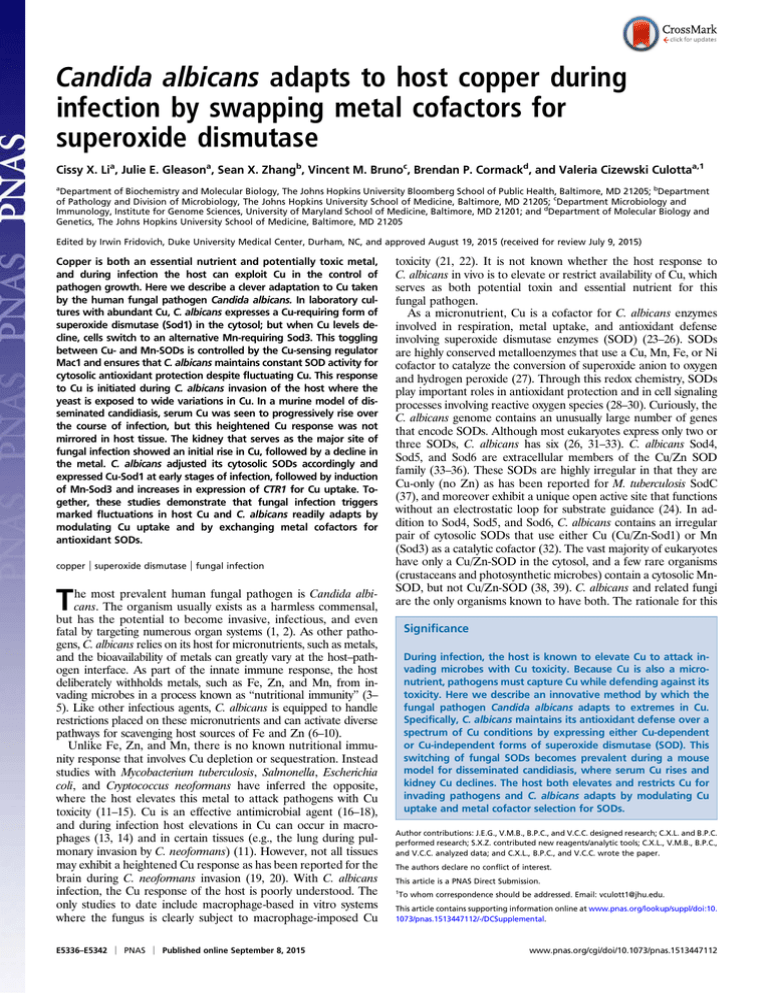
Candida albicans adapts to host copper during infection by swapping metal cofactors for superoxide dismutase Cissy X. Lia, Julie E. Gleasona, Sean X. Zhangb, Vincent M. Brunoc, Brendan P. Cormackd, and Valeria Cizewski Culottaa,1 a Department of Biochemistry and Molecular Biology, The Johns Hopkins University Bloomberg School of Public Health, Baltimore, MD 21205; bDepartment of Pathology and Division of Microbiology, The Johns Hopkins University School of Medicine, Baltimore, MD 21205; cDepartment Microbiology and Immunology, Institute for Genome Sciences, University of Maryland School of Medicine, Baltimore, MD 21201; and dDepartment of Molecular Biology and Genetics, The Johns Hopkins University School of Medicine, Baltimore, MD 21205 Edited by Irwin Fridovich, Duke University Medical Center, Durham, NC, and approved August 19, 2015 (received for review July 9, 2015) Copper is both an essential nutrient and potentially toxic metal, and during infection the host can exploit Cu in the control of pathogen growth. Here we describe a clever adaptation to Cu taken by the human fungal pathogen Candida albicans. In laboratory cultures with abundant Cu, C. albicans expresses a Cu-requiring form of superoxide dismutase (Sod1) in the cytosol; but when Cu levels decline, cells switch to an alternative Mn-requiring Sod3. This toggling between Cu- and Mn-SODs is controlled by the Cu-sensing regulator Mac1 and ensures that C. albicans maintains constant SOD activity for cytosolic antioxidant protection despite fluctuating Cu. This response to Cu is initiated during C. albicans invasion of the host where the yeast is exposed to wide variations in Cu. In a murine model of disseminated candidiasis, serum Cu was seen to progressively rise over the course of infection, but this heightened Cu response was not mirrored in host tissue. The kidney that serves as the major site of fungal infection showed an initial rise in Cu, followed by a decline in the metal. C. albicans adjusted its cytosolic SODs accordingly and expressed Cu-Sod1 at early stages of infection, followed by induction of Mn-Sod3 and increases in expression of CTR1 for Cu uptake. Together, these studies demonstrate that fungal infection triggers marked fluctuations in host Cu and C. albicans readily adapts by modulating Cu uptake and by exchanging metal cofactors for antioxidant SODs. copper | superoxide dismutase | fungal infection T he most prevalent human fungal pathogen is Candida albicans. The organism usually exists as a harmless commensal, but has the potential to become invasive, infectious, and even fatal by targeting numerous organ systems (1, 2). As other pathogens, C. albicans relies on its host for micronutrients, such as metals, and the bioavailability of metals can greatly vary at the host–pathogen interface. As part of the innate immune response, the host deliberately withholds metals, such as Fe, Zn, and Mn, from invading microbes in a process known as “nutritional immunity” (3– 5). Like other infectious agents, C. albicans is equipped to handle restrictions placed on these micronutrients and can activate diverse pathways for scavenging host sources of Fe and Zn (6–10). Unlike Fe, Zn, and Mn, there is no known nutritional immunity response that involves Cu depletion or sequestration. Instead studies with Mycobacterium tuberculosis, Salmonella, Escherichia coli, and Cryptococcus neoformans have inferred the opposite, where the host elevates this metal to attack pathogens with Cu toxicity (11–15). Cu is an effective antimicrobial agent (16–18), and during infection host elevations in Cu can occur in macrophages (13, 14) and in certain tissues (e.g., the lung during pulmonary invasion by C. neoformans) (11). However, not all tissues may exhibit a heightened Cu response as has been reported for the brain during C. neoformans invasion (19, 20). With C. albicans infection, the Cu response of the host is poorly understood. The only studies to date include macrophage-based in vitro systems where the fungus is clearly subject to macrophage-imposed Cu E5336–E5342 | PNAS | Published online September 8, 2015 toxicity (21, 22). It is not known whether the host response to C. albicans in vivo is to elevate or restrict availability of Cu, which serves as both potential toxin and essential nutrient for this fungal pathogen. As a micronutrient, Cu is a cofactor for C. albicans enzymes involved in respiration, metal uptake, and antioxidant defense involving superoxide dismutase enzymes (SOD) (23–26). SODs are highly conserved metalloenzymes that use a Cu, Mn, Fe, or Ni cofactor to catalyze the conversion of superoxide anion to oxygen and hydrogen peroxide (27). Through this redox chemistry, SODs play important roles in antioxidant protection and in cell signaling processes involving reactive oxygen species (28–30). Curiously, the C. albicans genome contains an unusually large number of genes that encode SODs. Although most eukaryotes express only two or three SODs, C. albicans has six (26, 31–33). C. albicans Sod4, Sod5, and Sod6 are extracellular members of the Cu/Zn SOD family (33–36). These SODs are highly irregular in that they are Cu-only (no Zn) as has been reported for M. tuberculosis SodC (37), and moreover exhibit a unique open active site that functions without an electrostatic loop for substrate guidance (24). In addition to Sod4, Sod5, and Sod6, C. albicans contains an irregular pair of cytosolic SODs that use either Cu (Cu/Zn-Sod1) or Mn (Sod3) as a catalytic cofactor (32). The vast majority of eukaryotes have only a Cu/Zn-SOD in the cytosol, and a few rare organisms (crustaceans and photosynthetic microbes) contain a cytosolic MnSOD, but not Cu/Zn-SOD (38, 39). C. albicans and related fungi are the only organisms known to have both. The rationale for this Significance During infection, the host is known to elevate Cu to attack invading microbes with Cu toxicity. Because Cu is also a micronutrient, pathogens must capture Cu while defending against its toxicity. Here we describe an innovative method by which the fungal pathogen Candida albicans adapts to extremes in Cu. Specifically, C. albicans maintains its antioxidant defense over a spectrum of Cu conditions by expressing either Cu-dependent or Cu-independent forms of superoxide dismutase (SOD). This switching of fungal SODs becomes prevalent during a mouse model for disseminated candidiasis, where serum Cu rises and kidney Cu declines. The host both elevates and restricts Cu for invading pathogens and C. albicans adapts by modulating Cu uptake and metal cofactor selection for SODs. Author contributions: J.E.G., V.M.B., B.P.C., and V.C.C. designed research; C.X.L. and B.P.C. performed research; S.X.Z. contributed new reagents/analytic tools; C.X.L., V.M.B., B.P.C., and V.C.C. analyzed data; and C.X.L., B.P.C., and V.C.C. wrote the paper. The authors declare no conflict of interest. This article is a PNAS Direct Submission. 1 To whom correspondence should be addressed. Email: vculott1@jhu.edu. This article contains supporting information online at www.pnas.org/lookup/suppl/doi:10. 1073/pnas.1513447112/-/DCSupplemental. www.pnas.org/cgi/doi/10.1073/pnas.1513447112 apparent redundancy in SODs with different metal cofactors was not known. In the present study, we investigated the basis for overlapping SODs in the C. albicans cytosol and have uncovered a new adaptation to Cu deficiency in this yeast. We observe that rapidly growing cultures of C. albicans with abundant Cu exclusively express Cu/Zn-Sod1. However, when Cu is depleted, cells will switch to expressing Mn-Sod3 through a mechanism involving the Cusensing transcription factor Mac1 (40, 41). Notably, this swapping of metallo-SOD enzymes becomes prevalent during C. albicans invasion of the kidney in a mouse model for disseminated candidiasis. During fungal infection, the host responds with marked variations in Cu availability and C. albicans adapts by modulating Cu transport genes and cofactor selection for SODs. Results Alternating Cu and Mn SOD Enzymes in C. albicans. Of the two cy- tosolic SODs in C. albicans, Cu/Zn-Sod1 appears as the predominant form under laboratory growth conditions. As seen in Fig. 1, lane 1, rapidly dividing cultures copiously produce Cu/ZnSod1 protein and enzymatic activity, but Mn-Sod3 is virtually absent. We tested whether this preference for Sod1 reflected metal availability. Yeast cells can be depleted for Cu by treating with increasing concentrations of the Cu(I) chelator bathocuproine sulphonate (BCS) (Fig. 1, Top). We observed that as intracellular Cu levels declined, cells progressively switched from expressing Cu/Zn-Sod1 to Mn-Sod3, and the transition occurred in both SOD protein accumulation (Fig. 1, Middle) and SOD enzymatic activity (Fig. 1, Bottom). This toggling of SOD enzymes in response to Cu is seen with both budding cultures of C. albicans (Fig. 1) and filamentous/hyphal forms of the yeast (Fig. 2A) that are particularly important for tissue invasion (42). Moreover, this phenomena is an inherent property of infectious C. albicans and was seen in three independent clinical isolates, including one from patient’s blood and two from the respiratory Li et al. Fig. 2. Alternating SOD enzymes in hyphal yeast and in clinical isolates of C. albicans. (A) A log-phase culture of CA-IF100 at 30 °C (“budding”) was incubated in water for 60 min at 30 °C (“starved”), and then induced to form hyphae by incubating in YPD medium + serum at 37 °C for 6 h (“hyphal”). Where indicated (“hyphal +BCS”), 800 μM BCS was added during hyphal formation. Sod1 and Sod3 expression was analyzed by immunoblot (Upper) and yeast cell morphology by light microscopy (Lower). (Magnification: 40×.) (B) Three clinical isolates of C. albicans isolated from human blood, the respiratory tract, and a fluconazole-resistant (FlucR) isolate from the respiratory tract were grown as in Fig. 1, with cells treated where indicated with 800 μM BCS; the laboratory strain CA-IF100 served as control. Sod1 and Sod3 expression was determined by immunoblot. PNAS | Published online September 8, 2015 | E5337 PNAS PLUS MICROBIOLOGY Fig. 1. C. albicans will switch from Cu/Zn-Sod1 to Mn-Sod3 enzyme in response to Cu starvation. A log-phase culture of C. albicans strain CA-IF100 was grown for 12 h in the presence of increasing concentrations of the Cu(I) chelator BCS. Intracellular Cu levels were monitored by atomic absorption spectroscopy (AAS) (Top), Sod1 and Sod3 protein levels by immunoblot (Middle), and SOD activity by the native gel assay (Bottom). AAS results represent the average of technical duplicates. Positions of Cu/Zn Sod1 (“Cu-Sod1”), Mn-Sod2, and Mn-Sod3 migration on the native gel and of Sod1 and Sod3 on the denaturing gel are indicated. Sod2 is the Mn-containing SOD of the mitochondrial matrix that is highly similar to cytosolic Sod3 (32) but remains constant with varied Cu. tract, one of which shows resistance to the antifungal drug fluconazole (Fig. 2B). Previously, C. albicans was reported to switch from Cu/Zn-Sod1 to Mn-Sod3 as cells approached stationary phase (32). We now report that this transitioning to Mn-Sod3 is also because of Cu deprivation. Intracellular Cu typically decreases during stationary phase (Fig. 3A) to levels that induce the CTR1 Cu transporter gene (Fig. 3B), a hallmark of Cu deficiency in C. albicans (40, 41). As seen in Fig. 3C, the switch to Mn-Sod3 with stationary phase was totally abolished by supplementing cultures with Cu salts (Fig. S1). Irrespective of C. albicans growth or morphological state, high Cu favors Sod1, whereas low Cu induces Sod3. It is important to note that this switching of SODs in response to Cu is not an allor-nothing event. C. albicans meticulously fine-tunes the level of Cu-Sod1 versus Mn-Sod3 to accommodate a vast range of intracellular Cu levels (Fig. 1 and Fig. S1). Compared with extensive control by Cu, there was no change in Sod1 or Sod3 in response to Mn. As seen in Fig. 3D, high levels of intracellular Mn did not favor Mn-Sod3 expression over Cu/Zn-Sod1. Cu-starved cells have low Sod1 enzymatic activity in part because of loss of the catalytic cofactor for this SOD (Fig. 1) and we tested whether such losses in Sod1 activity trigger the switch to Mn-Sod3. As seen in Fig. 4A, the complete absence of Cu/Zn-Sod1 in a Mac1 is essential for Cu regulation of SOD1 and SOD3, as mac1Δ/Δ-null cells failed to switch to SOD3 upon Cu depletion, either through BCS treatment or during stationary phase growth (Fig. 4 B and C). Mutations in mac1Δ/Δ seemed to mimic high Cu with regard to constitutively expressing Cu/Zn-Sod1 (as in Fig. 3C and Fig. S1). However, Cu was not elevated in mac1Δ/Δ cells and if anything Cu was low (Fig. 4C, Lower), presumably reflecting loss of Ctr1 Cu transport as has been previously reported for mac1Δ/Δ strains (43). Cu starvation therefore works through Mac1 to induce SOD3 and repress SOD1. In Saccharomyces cerevisiae, Podospora anserina, and C. albicans, Mac1-like regulators recognize the 8-mer TTTGCTCA in the promoter region of target genes, with some flexibility in the T at the first position (41, 44–46). We identified a single Mac1 consensus site at SOD3 position: 146 (Fig. 5A), consistent with its induction by Mac1 during Cu starvation. No such sequences were noted in the SOD1 promoter, but a match was identified at intronic position +148 (Fig. 5A). To test if these sequences are responsible for SOD1 and SOD3 regulation, we engineered C. albicans strains to express genomic copies of SOD1 or SOD3 containing substitutions in the aforementioned Mac1 consensus sequences. As seen in Fig. 5B, loss of the putative Mac1 site in the SOD3 promoter totally abolished Mn-Sod3 induction by Cu starvation, whereas Cu/Zn-Sod1 was still repressed (Fig. 5B, lane 6). Conversely, mutating the downstream Mac1 consensus site in the SOD1 intron rendered cells unable to repress Cu/Zn-Sod1, whereas Mn-Sod3 induction was preserved (Fig. 5C, lane 6). These studies demonstrate that SOD1 and SOD3 are regulated independently of one another and that this regulation Fig. 3. Induction of Sod3 during stationary-phase growth is caused by diminishing Cu. (A and B) CA-IF100 cells were grown for either 12 (log) or 48 h (stationary) before analysis of total Cu by AAS (A) or CTR1 expression by qRT-PCR compared with TUB2 mRNA (B) as described in Materials and Methods. (C) Immunoblot analysis of Sod1 and Sod3 was carried out on logphase cells (“0”) that where indicated, were grown for an additional 24 or 48 h with or without 8 mM CuSO4. (D) The 48-h stationary phase cultures (“0”) were diluted back to an OD600 = 0.1 in fresh medium and grown for the designated time points with 1 mM MnCl2, as indicated. Total intracellular Mn (Lower) was measured by AAS. Despite elevating Mn levels by several orders of magnitude, log phase cells only express Sod1. sod1Δ/Δ strain was not sufficient to induce Mn-Sod3 (Fig. 4A, lane 2); only Cu starvation was effective (Fig. 4A, lane 5). Conversely, absence of Sod3 in the sod3Δ/Δ strain did not impact Sod1 regulation by Cu (Fig. 4A, lanes 3 and 6). Therefore, it is changes in intracellular Cu and not SOD enzymatic activity that dictates expression of Cu/Zn-Sod1 versus Mn-Sod3. Mac1 as the Transregulator for SOD1 and SOD3. Cu-regulation of C. albicans SODs occurs at the mRNA level. As seen in Fig. 4B, SOD1 and SOD3 mRNA are reciprocally expressed in response to Cu depletion induced by either BCS or by growth in stationary phase. As an attractive candidate for this regulation, we examined Mac1, the Cu-sensing transcription factor that induces CTR1 Cu uptake in response to low Cu (40, 41, 43). We find that E5338 | www.pnas.org/cgi/doi/10.1073/pnas.1513447112 Fig. 4. Role of Mac1 in regulating SOD1 and SOD3 mRNA by Cu. (A and C, Upper) Immunoblot analysis of Sod1 and Sod3 with the indicated strains grown to log phase and supplemented where indicated with 800 μM BCS. (B) SOD1 and SOD3 mRNA were quantified by qRT-PCR in the indicated strains grown to log or stationary (48 h) phase in cultures supplemented with either 800 μM BCS or 8 mM CuSO4 where indicated. Results are shown as a comparison with TUB2 mRNA and represent the averages of three independent experimental trials where error bars are SE. (C, Lower) Cells from C, Upper were analyzed for intracellular Cu by AAS. Strains used: (A) WT CAIF100 and sod1Δ/Δ strain CA-IF003 and sod3Δ/Δ strain CA-IF011; (B and C) WT SN152 and isogenic mac1Δ/Δ TF065-X. Li et al. Fig. 5. Mac1 consensus sequences needed for regulation of SOD1 and SOD3 by Cu. (A) Mac1 consensus sequences in the SOD3 promoter and SOD1 intron are aligned against the published Mac1 binding site (41, 44–46). There appears to be some flexibility in the first position, as the 5′ T is substituted with a G in certain P. anserina target genes (44) and appears as A in SOD3. (B) A C. albicans sod3Δ/+ strain was engineered to express recombinant SOD3 that contained either the native Mac1 site at −146 or a ATTGCTCA to AcTtaagA substitution at this site. The parental and recombinant SOD3 derivatives were grown to log phase in the presence of 800 μM BCS where indicated and SOD expression analyzed by immunoblot. (C) The predicted Mac1 site in the SOD1 intron was analyzed similarly to that of SOD3 in B, except the starting strain was a sod1Δ/+ heterozygote engineered to express SOD1 with either native (TTTGCTCA) or the substituted (TcTtaagA) Mac1 site at +148. Discussion C. albicans has evolved an elaborate system for adjusting to Cu deficiency. In addition to inducing Cu uptake systems, the organism will substitute its Cu-requiring Sod1 enzyme with cytosolic Mn-Sod3. In this manner, the cell can maintain oxidative requires Mac1 consensus sequences in the SOD3 promoter and SOD1 intron. Mac1 is well known for its role as a transcriptional activator (40, 41, 44–49) but our studies with C. albicans SOD1 provide strong evidence that Mac1 can also act in gene repression using downstream consensus sites. Sod1 and Sod3 in an Infection Model for Disseminated Candidiasis. The natural habitat of C. albicans is the animal host and it was therefore critical to assess whether the organism alternates between Sod1 and Sod3 in vivo. Based on studies with other pathogens, host Cu is predicted to rise during infection (11, 13, 14, 50–52), calling into question the significance of a Cu starvation response in C. albicans. To investigate this, we used a murine model of disseminated candidiasis where kidney is the primary target organ of infection (53). In this model, C. albicans that is injected intravenously disappears from the blood within 5–10 h as the fungus disseminates to target tissues (54). Kidney abscesses appear as early as 24–48 h of infection and the animal typically succumbs to lethal candidiasis within a week (53). As seen in Fig. 6A, serum Cu levels progressively increased over the entire course of infection, consistent with the notion of elevated host Cu during infection and inflammation (11, 13, 14, 17, 18, 50–52). However, kidney Cu did not follow suit. There was a brief rise in kidney Cu at early stages of infection, but later stages were associated with reductions in total kidney Cu and levels consistently Li et al. Fig. 6. Cu responses during a murine model of disseminated candidiasis. Mice were infected with C. albicans by lateral tail vein injection as described in Materials and Methods. At the specified time points, serum and kidney were analyzed for Cu by AAS (A and B) and for expression of C. albicans SOD1 and SOD3 mRNA in infected kidneys (C). Cu analysis in A and B shows individual values from 5 to 13 mice at each time point. Statistical analysis was performed using one-way ANOVA with Tukey’s post hoc test where bar represents average. Statistically significant increases in serum Cu were observed (P < 0.001 for control vs. 72 h), and the decline in kidney Cu was also statistically significant (P < 0.001 for 24 h vs. 72 h). Kidney Cu is represented as nanogram of Cu per milligram wet weight of whole tissue (cortex and medulla combined). (C) SOD1 and SOD3 mRNA quantified by qRT-PCR was compared with that of C. albicans TUB2. Results shown are averages from 5 to 13 individual mice at each time point; error bars represent SE. PNAS | Published online September 8, 2015 | E5339 PNAS PLUS MICROBIOLOGY decreased between 24 and 72 h postinfection (Fig. 6B). This pattern was identical in isolated medulla and cortex sections of the kidney, indicative of tissue-wide changes in Cu (Fig. S2A). We also examined Cu in the spleen and liver where the fungal burden is three to four orders-of-magnitude lower than that of kidney based on CFUs (Fig. S2D). Trends in splenic Cu were similar to that of kidney (i.e., an initial rise, followed by decreases at later stages) (Fig. S2B), whereas Cu in the liver remained relatively constant with a slight elevation at 72 h (Fig. S2C). Overall, the progressive elevation in serum Cu during infection (Fig. 6A) is not mirrored in these tissues. To examine the impact of such changes in host Cu on C. albicans, we conducted quantitative RT-PCR (qRT-PCR) analysis of fungal SOD1 and SOD3 in kidneys, where fungal burden was the highest (Fig. S2D). As seen in Fig. 6C, early stages of infection were associated with abundant SOD1 and relatively low SOD3 mRNA, indicative of abundant Cu availability for the invading fungus. However, as infection proceeded, SOD1 was repressed and SOD3 was induced. Expression of the C. albicans CTR1 target of Mac1 was also elevated during later stages of infection (Fig. S2E). These studies demonstrate that at least in the kidney, the overall host response is not an elevation in toxic Cu, as was previously assumed. Host Cu can become limiting in the kidney during C. albicans infection and the pathogen responds by inducing a Cu-independent form of cytosolic SOD and a copper importer. stress protection in the cytosol over a wide range of environmental Cu conditions, including changes in Cu at the host– pathogen interface. The switch in C. albicans SODs during Cu starvation is mediated through the Cu sensing regulator Mac1, which is well known for its role as a positive regulator of Cu uptake genes in S. cerevisiae and C. albicans (40, 41, 49). C. albicans SOD3 can now be added to the list of transcriptional activation targets for Mac1. The Mac1 induction of SOD3 that we observe during kidney infection may very well explain why a sod1Δ/Δ C. albicans mutant shows only limited reductions in virulence (26). It will be important to test sod3Δ/Δ and the double sod1Δ/Δ sod3Δ/Δ strain in follow-up virulence studies. Mac1 regulation of SOD3 involves consensus sequences in the gene promoter; however, the puzzling downstream placement of the Mac1 consensus site in the SOD1 intron is unprecedented. Our studies demonstrate that this downstream site is essential for repression of SOD1 with low Cu. It is possible that Mac1 binding at this intronic site blocks progression of the transcriptional machinery or interacts with factors upstream for transcriptional initiation to down-regulate SOD1. In any case, this situation may not be unique to SOD1. In studies by Cashmore and colleagues, expression of the C. albicans SFU1 regulator of Fe homeostasis was elevated in mac1Δ/Δ strains (41), suggesting possible repression by Mac1, and we noted a possible Mac1 consensus sequence at downstream SFU1 position +141. Thus, C. albicans Mac1 may serve an expansive function in Cu-regulated gene control to both activate and repress gene expression depending on positioning of its consensus binding sequence. A well-accepted concept in innate immunity is host-imposed Cu toxicity, where elevated Cu serves as an effective biocide against microbial pathogens (11, 13, 14, 17, 18, 50–52). Our studies reveal two faces of host Cu during infection with C. albicans: while serum Cu elevates, Cu can become limiting at the major site of infection in the kidney. As one possibility, the host may intentionally restrict Cu as part of an innate nutritional immunity response, similar to host withholding of Fe, Mn, and Zn for invading microbes (3–10). Recent studies by Brown and colleagues have shown that during C. albicans infection of the kidney, Fe moves away from sites of fungal lesions in the cortex to the medulla as an apparent mechanism for Fe withholding (9). However, we observe no similar movement of Cu toward the medulla; rather, the drop in Cu is kidney-wide. Furthermore, this is not caused by increased urinary output because urine levels of Cu seem to follow kidney Cu and decline from 24 to 72 h of infection (Fig. S3). If the kidney is not losing Cu by excretion, the metal should be reabsorbed into circulation, perhaps contributing to the continual rise in serum Cu. It is noteworthy that the majority of serum Cu is in the form of the acute-phase cuproprotein ceruloplasm, largely produced by the liver (50, 55, 56). We find that the liver does not follow the same late-stage decline in Cu seen with kidney and spleen, raising the intriguing possibility that Cu may be mobilized from nonliver tissues to meet the demands for elevating serum Cu and ceruloplasm production by the liver. Interestingly, a similar pattern of heightened serum Cu and reduced kidney and spleen Cu was seen in infections with Coxsackie virus (57), indicating that such fluxes in whole-animal Cu may be common to diverse infectious agents. Elegant studies by Kim et al. (58) have demonstrated a cross-tissue communication of Cu status whereby Cu deficiencies in one tissue (e.g., heart) send out a signal to mobilize Cu from other tissues (e.g., liver) to compensate for the metal deficiency (58, 59). It is possible that a similar communication occurs during infection to account for the fluxes in tissue and blood stream Cu we report here. Although the mechanism of Cu mobilization in the kidney and spleen is still unknown, a possibility includes regulation of the ATP7A or ATP7B Cu efflux transporters, which could be addressed in future studies using available mouse models (60, 61). E5340 | www.pnas.org/cgi/doi/10.1073/pnas.1513447112 Together, these studies demonstrate that the host response to infection is not simply to attack pathogens with toxic Cu, but that Cu can become limiting during infection as well. C. albicans is well equipped to withstand restrictions in host Cu by adjusting Cu uptake and the utilization of Cu as an enzymatic cofactor for SOD enzymes. Both adaptations are mediated by the fungal Mac1 transregulator and it will be of great interest to assess in future studies the impact of disrupting Mac1 control on C. albicans virulence, particularly in lethal kidney infections. Materials and Methods Yeast Strains and Culture Conditions. All of the C. albicans laboratory strains used in this study are derivatives of SC5314 and include: CA-IF100 (arg4Δ/ arg4Δ, leu2Δ/leu2Δ::cmLEU2, his1Δ/his1Δ::cdHIS1, URA3/ura3Δ) and the isogenic strains CA-IF001 (sod1Δ::cmLEU2/SOD1), CA-IF003 (sod1Δ::cmLEU2/ sod1Δ::cdHIS1), CA-IF009 (sod3Δ::cmLEU2/SOD3), and CA-IF011 (sod3Δ:: cmLEU2/sod3Δ::cdHIS1), obtained from K. Kuchler, Medical University of Austria, Vienna (35); SN152 (his1Δ/his1Δ, leu2Δ /leu2Δ, arg4Δ /arg4Δ, URA3/ura3Δ:: imm434, IRO1/iro1Δ::imm434) and two independent isogenic mac1Δ::LEU2/ mac1Δ::HIS1 isolates, TF065-X and TF065-Y [Fungal Genetics Stock Center (62, 63)]. The three clinical isolates were random blind samples obtained from the repository at The Johns Hopkins Hospital Clinical Microbiology Laboratory. Samples were isolated from either the blood or respiratory tract of patients and one of the isolates was resistant to fluconazole, as determined by the YeastOne YO-9 panel (TREK Diagnostic Systems). C. albicans speciation was determined by standard laboratory procedures, including positive germ tube testing, colorimetric growth on Chromagar plates, and microscopic examination. It was also differentiated from Candida dubliniensis by a PNA-FISH test (AdvanDx) and BD Phoenix panel (Becton Dickinson). To engineer strains expressing SOD1 and SOD3 with mutant Mac1 consensus sequences, an ends-in recombination method (64), was used using gene-replacement plasmids constructed as follows: SOD1 sequences −1,000 to +506 were amplified using primers that introduced terminal Not1 and Apa1 sites at the upstream and downstream positions. The Apa1 site was preceded by a triple stop codon that would terminate Sod1 translation at residue 87. SOD3 sequences −1,000 to +351 were similarly amplified with stop codons engineered at amino acid position 97. PCR products were digested with NotI and Apa1 and inserted into these same sites of pSN52 (65), containing the C. dubliniensis (Cd) HIS1 marker. A BplI restriction site was engineered at positions +358 and +200 in SOD1 and SOD3, respectively, to drive integration of the plasmid at the corresponding genomic loci. The resultant pCL13 (SOD1) and pCL14 (SOD3) plasmids were subjected to a second round of mutagenesis to alter the Mac1 consensus sequence to contain an AflII restriction site: TTTGCTCA to TCTTAAGA at +148 in SOD1 (generating pCL15), and GTTGCTCA to GCTTAAGA at −153 in SOD3 (pCL16). Plasmids pCL13-16 were linearized with BplI and used to transform either the sod1Δ/+ heterozygote strain CA-IF001 (pCL13 and pCL15) or the CAIF009 sod3Δ/+ strain (pCL14 and pCL15). Faithful integration of the plasmids resulted in a tandem duplication of SOD1 or SOD3 sequences, including a truncated nonfunctional protein and a full-length protein associated with either mutated or unaltered Mac1 consensus sequences. Plasmid sequences and accurate chromosomal integration were verified by PCR amplification, restriction digestion, and gene sequencing. For laboratory growth of C. albicans, budding cells were typically cultured at 30 °C in enriched media (YPD; BD Difco) containing yeast extract, peptone, and 2% (wt/vol) dextrose. Log-phase cultures were obtained by 12- to 16-h growth to an OD600 between 1 and 4. Stationary phase cultures were obtained by 24- to 48-h growth following a starting OD600 of 0.1. To obtain hyphal yeast, a log-phase culture of budding C. albicans was starved in water at a concentration of OD600 = 3 for 1 h at 30 °C, then diluted in YPD medium with 10% (vol/vol) FBS (Sigma) at OD600 = 0.1 and grown for 6 h at 37 °C. Light microscopy of budding and hyphal cells was carried out at 40× using an Eclipse 80i upright microscope (Nikon) equipped with a dry dark field condenser (Nikon). The Murine Infection Model for Disseminated Candidiasis. The mouse studies were carried out in accordance with the National Institutes of Health guidelines for the ethical treatment of animals. This protocol was approved by the Institutional Animal Care and Use Committee of the Johns Hopkins University medical institutions, protocol number MO13M264. Studies involved both males and females with no difference noted with sex under any parameter tested. Six- to 8-wk-old Balb/C mice were infected by lateral tail vein injection with 5 × 105 yeast cells of C. albicans SC5314. After 24, 48, and 72 h of infection, 5–13 mice per time point were killed, along with 5 control Li et al. Biochemical Analysis. For analysis of SOD protein and enzyme activity, wholecell lysates were extracted from C. albicans by bead homogenization (66). SOD activity analysis was carried out by native gel electrophoresis and nitroblue tetrazolium staining precisely as described previously (66). Immunoblot analysis of Sod1 and Sod3 followed published procedures (66), where the blot was probed first with anti-Sod3 antibody then washed three times in buffer containing 0.1% Tween-20 before probing with anti-Sod1 antibody and incubation with an anti-rabbit secondary antibody, as described previously (66). The immunoblots were imaged using an Odyssey infrared imaging system (LI-COR Biosciences). Metal analysis of C. albicans cells in culture and of infected mouse tissues by AAS was performed on a PerkinElmer Life Sciences AAnalyst 600 graphite furnace atomic absorption spectrometer. With C. albicans cultures, 10 OD600 units of cells were washed twice in 10 mM Tris, 1 mM EDTA, pH 8, and twice in deionized water and resuspended in 1 mL of deionized water before analysis of Cu and Mn by AAS. Mouse tissue samples [typically 20–200 mg wet weight per mL 20% (vol/vol) nitric acid] were diluted 1:50 in MilliQ deionized water, and serum and urine samples were similarly diluted 1:20 or 1:50 before Cu analysis by AAS. 1. Perlroth J, Choi B, Spellberg B (2007) Nosocomial fungal infections: Epidemiology, diagnosis, and treatment. Med Mycol 45(4):321–346. 2. Seeliger HP (1976) Opportunistic fungal infections with particular reference of Candida albicans. Mykosen 19(3):87–97. 3. Cassat JE, Skaar EP (2013) Iron in infection and immunity. Cell Host Microbe 13(5): 509–519. 4. Drakesmith H, Prentice AM (2012) Hepcidin and the iron-infection axis. Science 338(6108):768–772. 5. Kehl-Fie TE, Skaar EP (2010) Nutritional immunity beyond iron: A role for manganese and zinc. Curr Opin Chem Biol 14(2):218–224. 6. Chen C, Pande K, French SD, Tuch BB, Noble SM (2011) An iron homeostasis regulatory circuit with reciprocal roles in Candida albicans commensalism and pathogenesis. Cell Host Microbe 10(2):118–135. 7. Kuznets G, et al. (2014) A relay network of extracellular heme-binding proteins drives C. albicans iron acquisition from hemoglobin. PLoS Pathog 10(10):e1004407. 8. Noble SM (2013) Candida albicans specializations for iron homeostasis: From commensalism to virulence. Curr Opin Microbiol 16(6):708–715. 9. Potrykus J, et al. (2013) Fungal iron availability during deep seated candidiasis is defined by a complex interplay involving systemic and local events. PLoS Pathog 9(10): e1003676. 10. Xu W, et al. (2015) Activation and alliance of regulatory pathways in C. albicans during mammalian infection. PLoS Biol 13(2):e1002076. 11. Ding C, et al. (2013) Cryptococcus neoformans copper detoxification machinery is critical for fungal virulence. Cell Host Microbe 13(3):265–276. 12. Wolschendorf F, et al. (2011) Copper resistance is essential for virulence of Mycobacterium tuberculosis. Proc Natl Acad Sci USA 108(4):1621–1626. 13. Wagner D, et al. (2005) Elemental analysis of Mycobacterium avium-, Mycobacterium tuberculosis-, and Mycobacterium smegmatis-containing phagosomes indicates pathogeninduced microenvironments within the host cell’s endosomal system. J Immunol 174(3):1491–1500. 14. White C, Lee J, Kambe T, Fritsche K, Petris MJ (2009) A role for the ATP7A coppertransporting ATPase in macrophage bactericidal activity. J Biol Chem 284(49): 33949–33956. 15. Ladomersky E, Petris MJ (2015) Copper tolerance and virulence in bacteria. Metallomics 7(6):957–964. 16. Festa RA, Helsel ME, Franz KJ, Thiele DJ (2014) Exploiting innate immune cell activation of a copper-dependent antimicrobial agent during infection. Chem Biol 21(8): 977–987. 17. Fu Y, Chang FM, Giedroc DP (2014) Copper transport and trafficking at the hostbacterial pathogen interface. Acc Chem Res 47(12):3605–3613. 18. García-Santamarina S, Thiele DJ (2015) Copper at the fungal pathogen-host axis. J Biol Chem 290(31):18945–18953. 19. Sun TS, et al. (2014) Reciprocal functions of Cryptococcus neoformans copper homeostasis machinery during pulmonary infection and meningoencephalitis. Nat Commun 5:5550. Li et al. ACKNOWLEDGMENTS. We thank K. Kuchler for kind gifts of Candida albicans strains; and C. Gomez, E. Hwang-Wong, C. Broxton, A. Muchenditsi, and A. Batazzi for technical advice and for assistance with harvesting animal tissues. This work was supported by National Institutes of Health Research Grants R21 AI097715, R37 GM50016, and R01 AI119949 (to V.C.C.), R01 AI046223 (to B.P.C.), and U19AI110820 (to V.M.B.); and Grant T32 ES07141 (to C.X.L.). 20. Waterman SR, et al. (2012) Role of CTR4 in the virulence of Cryptococcus neoformans. MBio 3(5):e00285-12. 21. Douglas LM, Wang HX, Keppler-Ross S, Dean N, Konopka JB (2012) Sur7 promotes plasma membrane organization and is needed for resistance to stressful conditions and to the invasive growth and virulence of Candida albicans. MBio 3(1):e00254-11. 22. Weissman Z, Berdicevsky I, Cavari BZ, Kornitzer D (2000) The high copper tolerance of Candida albicans is mediated by a P-type ATPase. Proc Natl Acad Sci USA 97(7): 3520–3525. 23. Cheng X, et al. (2013) Novel insight into the expression and function of the multicopper oxidases in Candida albicans. Microbiology 159(Pt 6):1044–1055. 24. Gleason JE, et al. (2014) Candida albicans SOD5 represents the prototype of an unprecedented class of Cu-only superoxide dismutases required for pathogen defense. Proc Natl Acad Sci USA 111(16):5866–5871. 25. Helmerhorst EJ, Stan M, Murphy MP, Sherman F, Oppenheim FG (2005) The concomitant expression and availability of conventional and alternative, cyanide-insensitive, respiratory pathways in Candida albicans. Mitochondrion 5(3):200–211. 26. Hwang CS, et al. (2002) Copper- and zinc-containing superoxide dismutase (Cu/ZnSOD) is required for the protection of Candida albicans against oxidative stresses and the expression of its full virulence. Microbiology 148(Pt 11):3705–3713. 27. Sheng Y, et al. (2014) Superoxide dismutases and superoxide reductases. Chem Rev 114(7):3854–3918. 28. Juarez JC, et al. (2008) Superoxide dismutase 1 (SOD1) is essential for H2O2-mediated oxidation and inactivation of phosphatases in growth factor signaling. Proc Natl Acad Sci USA 105(20):7147–7152. 29. Reddi AR, Culotta VC (2013) SOD1 integrates signals from oxygen and glucose to repress respiration. Cell 152(1-2):224–235. 30. Tsang CK, Liu Y, Thomas J, Zhang Y, Zheng XF (2014) Superoxide dismutase 1 acts as a nuclear transcription factor to regulate oxidative stress resistance. Nat Commun 5:3446. 31. Hwang CS, Baek YU, Yim HS, Kang SO (2003) Protective roles of mitochondrial manganese-containing superoxide dismutase against various stresses in Candida albicans. Yeast 20(11):929–941. 32. Lamarre C, LeMay JD, Deslauriers N, Bourbonnais Y (2001) Candida albicans expresses an unusual cytoplasmic manganese-containing superoxide dismutase (SOD3 gene product) upon the entry and during the stationary phase. J Biol Chem 276(47): 43784–43791. 33. Martchenko M, Alarco AM, Harcus D, Whiteway M (2004) Superoxide dismutases in Candida albicans: Transcriptional regulation and functional characterization of the hyphal-induced SOD5 gene. Mol Biol Cell 15(2):456–467. 34. Fradin C, et al. (2005) Granulocytes govern the transcriptional response, morphology and proliferation of Candida albicans in human blood. Mol Microbiol 56(2):397–415. 35. Frohner IE, Bourgeois C, Yatsyk K, Majer O, Kuchler K (2009) Candida albicans cell surface superoxide dismutases degrade host-derived reactive oxygen species to escape innate immune surveillance. Mol Microbiol 71(1):240–252. PNAS | Published online September 8, 2015 | E5341 PNAS PLUS For qRT-PCR analysis of RNA from C. albicans cultures, RNA was isolated from 30 OD600 cell units by acid phenol extraction and ethanol precipitation, followed by cDNA synthesis as described previously (67). Real-time PCR was essentially as described previously (67) using standard curves generated with 50-fold serial dilutions of genomic DNA from C. albicans strain SN152. cDNAs were diluted 20-fold before PCR amplification with EvaGreen (Biotium), and values were normalized to TUB2 transcripts in each sample. Amplicons of ∼150 bp were obtained using the following primers: SOD1: CTACTGATGGTAATGGTGTTGCTAA and CCAGCATGACCAGTAGTTTTAGAAT; SOD3: CAGTATGGGTCTGTTTCAAACCTTA and GATATTGCAAGTAGTACGCATGTTC; CTR1: CAAAAGCTCGTGGAACCGGTAAATC and TCAGCAACAAATCTTCCAACACCGG; TUB2: GAGTTGGTGATCAATTCAGTGCTAT and ATGGCGGCATCTTCTAATGGGATTT. The thermal cycling conditions were as described previously (67), except 39 cycles were used and an annealing temperature of 55 °C rather than 60 °C. For infected kidneys, samples stored in RNA-later were diced and placed in 1 mL of TriPure Isolation Reagent (Roche), followed by homogenization using a Polytron 1200e tissue homogenizer (Kinematica), and vortexing with 0.5-mm zirconia beads for 30 min at 4 °C. Homogenate was clarified by centrifugation and incubated at room temperature for 30 min before organic extraction of RNA using TriPure Isolation Reagent. RNA was purified further via NucleoSpin RNA kit (Machery-Nagel). cDNA was synthesized using the SuperScript III kit (Life Technologies), followed by PCR amplification using the iQ SYBR Green Supermix (Bio-Rad) as described above for yeast cultures, except that 50 cycles were completed. MICROBIOLOGY uninfected mice. Blood was collected, allowed to congeal on ice for 30 min, and then centrifuged at 1,000 × g for 10 min to isolate serum. Before harvesting, tissues were perfused by injecting 10 mL sterile PBS into the left ventricle of the heart and by draining from an incision in the right atrium. With each mouse, one kidney was stored in 1 mL RNA-later (Sigma) at −80 °C and the second was bisected sagittally. One half was homogenized and serially diluted to determine CFUs and the other half was dissected into cortex and medulla and dissolved in 1 mL of 20% (vol/vol) Ultrex II Ultrapure nitric acid overnight at 90 °C in preparation for metal analysis by atomic absorption spectroscopy (AAS, see below). Liver and spleen were similarly prepped for determination of CFUs and metal analysis. Just before being killed, urine was collected from live mice placed on Parafilm, and was centrifuged at 13,000 × g to remove debris. 36. Miramón P, et al. (2012) Cellular responses of Candida albicans to phagocytosis and the extracellular activities of neutrophils are critical to counteract carbohydrate starvation, oxidative and nitrosative stress. PLoS One 7(12):e52850. 37. Spagnolo L, et al. (2004) Unique features of the sodC-encoded superoxide dismutase from Mycobacterium tuberculosis, a fully functional copper-containing enzyme lacking zinc in the active site. J Biol Chem 279(32):33447–33455. 38. Allen MD, Kropat J, Tottey S, Del Campo JA, Merchant SS (2007) Manganese deficiency in Chlamydomonas results in loss of photosystem II and MnSOD function, sensitivity to peroxides, and secondary phosphorus and iron deficiency. Plant Physiol 143(1):263–277. 39. Brouwer M, Hoexum Brouwer T, Grater W, Brown-Peterson N (2003) Replacement of a cytosolic copper/zinc superoxide dismutase by a novel cytosolic manganese superoxide dismutase in crustaceans that use copper (haemocyanin) for oxygen transport. Biochem J 374(Pt 1):219–228. 40. Marvin ME, Mason RP, Cashmore AM (2004) The CaCTR1 gene is required for highaffinity iron uptake and is transcriptionally controlled by a copper-sensing transactivator encoded by CaMAC1. Microbiology 150(Pt 7):2197–2208. 41. Woodacre A, Mason RP, Jeeves RE, Cashmore AM (2008) Copper-dependent transcriptional regulation by Candida albicans Mac1p. Microbiology 154(Pt 5):1502–1512. 42. Gow NA, van de Veerdonk FL, Brown AJ, Netea MG (2012) Candida albicans morphogenesis and host defence: Discriminating invasion from colonization. Nat Rev Microbiol 10(2):112–122. 43. Schwartz JA, et al. (2013) Regulation of copper toxicity by Candida albicans GPA2. Eukaryot Cell 12(7):954–961. 44. Borghouts C, Scheckhuber CQ, Stephan O, Osiewacz HD (2002) Copper homeostasis and aging in the fungal model system Podospora anserina: Differential expression of PaCtr3 encoding a copper transporter. Int J Biochem Cell Biol 34(11):1355–1371. 45. Labbé S, Zhu Z, Thiele DJ (1997) Copper-specific transcriptional repression of yeast genes encoding critical components in the copper transport pathway. J Biol Chem 272(25):15951–15958. 46. Martins LJ, Jensen LT, Simon JR, Keller GL, Winge DR (1998) Metalloregulation of FRE1 and FRE2 homologs in Saccharomyces cerevisiae. J Biol Chem 273(37): 23716–23721. 47. Georgatsou E, Mavrogiannis LA, Fragiadakis GS, Alexandraki D (1997) The yeast Fre1p/Fre2p cupric reductases facilitate copper uptake and are regulated by the copper-modulated Mac1p activator. J Biol Chem 272(21):13786–13792. 48. Serpe M, Joshi A, Kosman DJ (1999) Structure-function analysis of the protein-binding domains of Mac1p, a copper-dependent transcriptional activator of copper uptake in Saccharomyces cerevisiae. J Biol Chem 274(41):29211–29219. 49. Yamaguchi-Iwai Y, et al. (1997) Homeostatic regulation of copper uptake in yeast via direct binding of MAC1 protein to upstream regulatory sequences of FRE1 and CTR1. J Biol Chem 272(28):17711–17718. E5342 | www.pnas.org/cgi/doi/10.1073/pnas.1513447112 50. Chaturvedi KS, Henderson JP (2014) Pathogenic adaptations to host-derived antibacterial copper. Front Cell Infect Microbiol 4:3. 51. Festa RA, Thiele DJ (2012) Copper at the front line of the host-pathogen battle. PLoS Pathog 8(9):e1002887. 52. Samanovic MI, Ding C, Thiele DJ, Darwin KH (2012) Copper in microbial pathogenesis: Meddling with the metal. Cell Host Microbe 11(2):106–115. 53. Clancy CJ, Cheng S, Nguyen MH (2009) Animal models of candidiasis. Methods Mol Biol 499:65–76. 54. MacCallum DM, Odds FC (2005) Temporal events in the intravenous challenge model for experimental Candida albicans infections in female mice. Mycoses 48(3):151–161. 55. Harris ZL, et al. (1995) Aceruloplasminemia: Molecular characterization of this disorder of iron metabolism. Proc Natl Acad Sci USA 92(7):2539–2543. 56. Hellman NE, Gitlin JD (2002) Ceruloplasmin metabolism and function. Annu Rev Nutr 22:439–458. 57. Molin Y, Frisk P, Ilbäck NG (2009) Viral RNA kinetics is associated with changes in trace elements in target organs of Coxsackie virus B3 infection. Microbes Infect 11(4): 493–499. 58. Kim BE, et al. (2010) Cardiac copper deficiency activates a systemic signaling mechanism that communicates with the copper acquisition and storage organs. Cell Metab 11(5):353–363. 59. Culotta V (2010) Speaking from the heart: Systemic copper signaling. Cell Metab 11(5):343–344. 60. Wang Y, et al. (2012) Maternofetal and neonatal copper requirements revealed by enterocyte-specific deletion of the Menkes disease protein. Am J Physiol Gastrointest Liver Physiol 303(11):G1236–G1244. 61. Gray LW, et al. (2012) Urinary copper elevation in a mouse model of Wilson’s disease is a regulated process to specifically decrease the hepatic copper load. PLoS One 7(6): e38327. 62. McCluskey K, Wiest A, Plamann M (2010) The Fungal Genetics Stock Center: A repository for 50 years of fungal genetics research. J Biosci 35(1):119–126. 63. Noble SM, French S, Kohn LA, Chen V, Johnson AD (2010) Systematic screens of a Candida albicans homozygous deletion library decouple morphogenetic switching and pathogenicity. Nat Genet 42(7):590–598. 64. Symington LS (2002) Role of RAD52 epistasis group genes in homologous recombination and double-strand break repair. Microbiol Mol Biol Rev 66(4):630–670. 65. Noble SM, Johnson AD (2005) Strains and strategies for large-scale gene deletion studies of the diploid human fungal pathogen Candida albicans. Eukaryot Cell 4(2): 298–309. 66. Gleason JE, Li CX, Odeh HM, Culotta VC (2014) Species-specific activation of Cu/Zn SOD by its CCS copper chaperone in the pathogenic yeast Candida albicans. J Biol Inorg Chem 19(4-5):595–603. 67. Beese-Sims SE, et al. (2012) Mutants in the Candida glabrata glycerol channels are sensitized to cell wall stress. Eukaryot Cell 11(12):1512–1519. Li et al.
